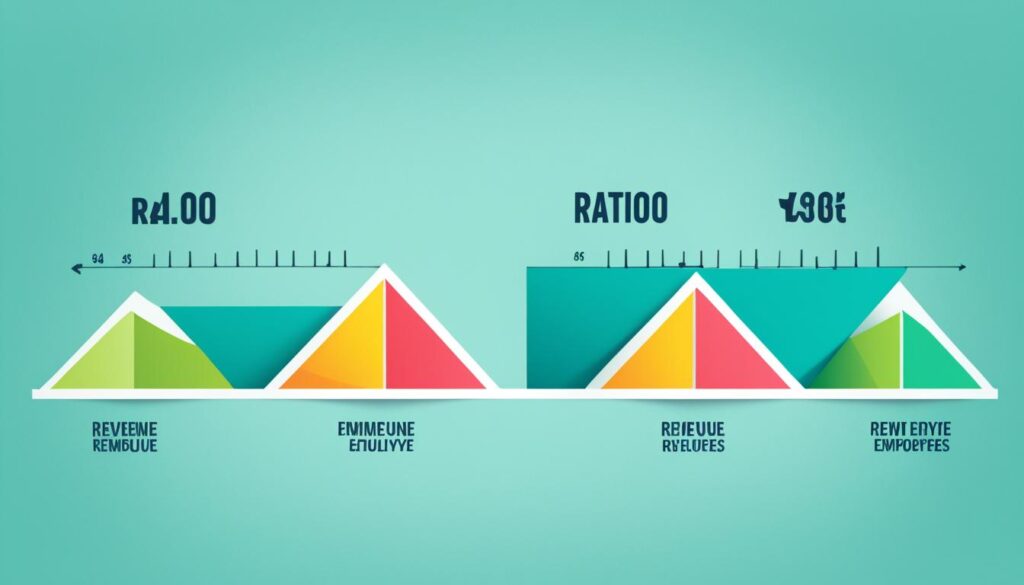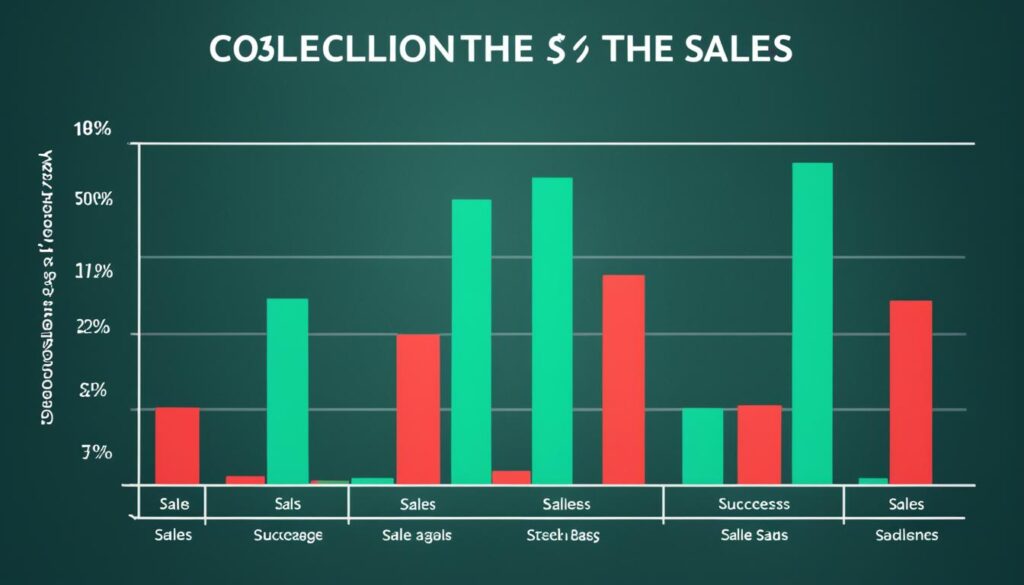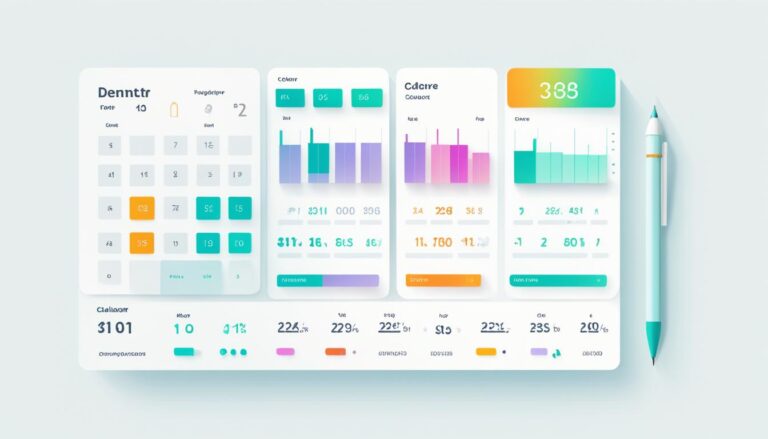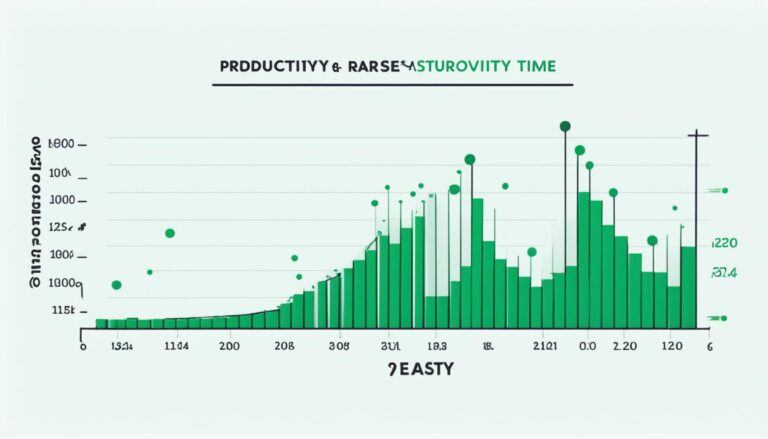Boost Your Success with Key Productivity Ratios

Do you know the secret to maximizing your business’s success? It lies in the power of productivity ratios. These efficiency metrics and performance indicators can unlock the key to optimizing your operational productivity and achieving higher levels of success. Are you ready to discover the ratios that can transform your business?
Productivity ratios such as labor productivity, resource utilization, and output to input ratio provide valuable insights into your business’s performance. By measuring and managing these ratios, you can identify areas for improvement and make data-driven decisions to drive growth. Whether you’re a small startup or a large corporation, understanding and harnessing the power of productivity ratios is essential for staying ahead in today’s competitive business landscape.
Key Takeaways:
- Productivity ratios are essential for measuring and managing business success.
- Efficiency metrics and performance indicators provide insights into operational productivity.
- Tracking ratios such as labor productivity and resource utilization helps identify areas for improvement.
- Optimizing productivity ratios can drive growth and increase your business’s chances of success.
- Understanding and utilizing productivity ratios is crucial for businesses of all sizes.
Employee Metrics for Efficiency
Two important employee metrics for measuring efficiency are employees per square foot and customers per account manager.
The employees per square foot ratio assesses how efficiently you have designed your workspace by dividing the number of square feet of office space by the number of employees. This metric takes into account virtual teams and work-from-home options, providing valuable insights into workspace utilization and optimizing resource allocation.
The customers per account manager ratio measures the balance between the number of customers assigned to each account manager. Finding the right ratio is crucial for effectively managing customer relationships, ensuring personalized attention, and maintaining high levels of customer satisfaction.
The Importance of Employees per Square Foot
Efficiently utilizing office space is vital for fostering productivity and creating a conducive work environment. The employees per square foot ratio highlights how well you are effectively using your workspace to accommodate your workforce. This metric can reveal valuable insights into your overall operational efficiency and resource allocation.
By optimizing your office layout and ensuring that each square foot is effectively utilized, you can maximize productivity and enhance collaboration among employees. A higher employees per square foot ratio indicates efficient space utilization and cost savings, while a low ratio may suggest the need for space optimization or potential expansion.
Implementing flexible work arrangements, such as remote work options and virtual teams, allows for an efficient use of office space. This enables employees to work from anywhere, reducing the need for excessive office space and ultimately improving the employees per square foot ratio. Embracing modern workplace trends can lead to increased employee satisfaction, higher productivity, and cost savings.
The Significance of Customers per Account Manager
Managing customer relationships effectively is essential for business success. The customers per account manager ratio helps you understand the workload distribution among your account managers and ensure optimal customer service.
Assigning a reasonable number of customers to each account manager enables them to provide personalized attention, address customer needs promptly, and build strong relationships. A balanced ratio allows account managers to allocate their time and resources effectively, ensuring that all customers receive the attention they deserve.
Additionally, analyzing the customers per account manager ratio can help identify the need for hiring additional account managers or streamlining processes to ensure efficient customer relationship management. Consistently monitoring and adjusting this ratio will enhance customer satisfaction, foster loyalty, and contribute to overall business growth.
| Ratio | Definition | Importance |
|---|---|---|
| Employees per Square Foot | Number of square feet of office space divided by the number of employees | Optimizes workspace utilization, reduces costs, and enhances productivity |
| Customers per Account Manager | Number of customers assigned to each account manager | Ensures personalized attention, improves customer satisfaction, and strengthens relationships |
The Ratio of Promoters to Detractors
Measuring employee satisfaction and loyalty is crucial for creating a positive and engaged workforce. The Ratio of Promoters to Detractors, also known as the Net Promoter Score (NPS), is a key metric that helps businesses gauge the level of employee satisfaction and engagement.
To calculate the NPS, companies ask employees how likely they are to recommend the company to others. This simple question provides valuable insights into the overall sentiment among employees. Those who score the company high are considered promoters, while those who score the company low are detractors. By calculating the ratio of promoters to detractors, businesses can obtain their Net Promoter Score.
A higher NPS indicates a more positive and engaged workforce. When employees are satisfied and loyal, they are more likely to go above and beyond in their roles, driving productivity and success. Moreover, satisfied employees are more likely to act as ambassadors for the company, attracting top talent and contributing to its growth.
Embedding a culture of employee satisfaction and engagement can have a far-reaching impact on organizational performance. It leads to reduced turnover, increased productivity, and improved customer satisfaction. By prioritizing employee satisfaction and actively managing the ratio of promoters to detractors, businesses can unlock their full potential.
Advantages of a High Net Promoter Score:
- Increased Productivity: A positive work environment and high levels of employee satisfaction result in increased productivity and effectiveness.
- Better Customer Service: Engaged employees who believe in the company and its products are more likely to provide exceptional customer service and enhance customer loyalty.
- Talent Attraction and Retention: A positive corporate culture and high NPS act as a magnet for top talent, making it easier to attract and retain skilled employees.
- Enhanced Employee Morale: Satisfied employees have higher morale, leading to better teamwork, collaboration, and overall job satisfaction.

Revenue per Employee (RPE)
When it comes to assessing your business’s performance and efficiency, revenue per employee (RPE) is a critical financial metric to consider. RPE measures the average revenue generated by each employee, providing valuable insights into your employee quality, company culture, employee-customer relations, and the overall health of your business.
Higher RPE numbers indicate better business performance and efficiency, as employees are generating more revenue for your organization. This metric allows you to track the productivity and effectiveness of your workforce. By benchmarking your industry’s average RPE, you can evaluate your business’s performance and identify areas for improvement.
It’s important to note that RPE values may vary across different industries. In general, larger corporations often achieve higher RPE numbers than smaller firms due to economies of scale and greater resources. However, every business should strive to maximize its RPE and continuously improve its performance.
Key Benefits of Measuring Revenue per Employee:
- Insights into employee quality and performance
- Indicators of company culture and employee satisfaction
- Understanding of the effectiveness of employee-customer relationships
- Identification of areas for improvement and optimization
By focusing on increasing your RPE, you can drive better business outcomes and achieve sustainable growth. This metric helps you align your business activities with revenue generation and prioritize employee productivity. It also highlights the connection between employee quality, customer satisfaction, and your organization’s financial success.

| Industry | Average RPE |
|---|---|
| Technology | $300,000 |
| Manufacturing | $200,000 |
| Retail | $150,000 |
| Financial Services | $400,000 |
The table above provides a glimpse into the average RPE across different industries. While the values may vary, it’s important to assess your RPE in the context of your industry and make strategic decisions accordingly.
By continuously monitoring and improving your RPE, you can optimize your business’s performance, enhance employee quality, and drive greater revenue. Remember, a strong RPE is a testament to your organization’s productivity and ability to generate value.
Operational Efficiency Ratio
Operational efficiency is the key to maximizing your company’s success and profitability. To effectively assess and optimize your operational efficiency, it is essential to understand and utilize key ratios that provide insights into your financial health. One such ratio is the operational efficiency ratio, also known as the operating ratio.
The operational efficiency ratio measures how efficiently your company manages costs while generating sales or revenue. It is calculated by dividing operating expenses and the cost of goods sold by net sales. This ratio provides a clear picture of your company’s ability to achieve profitability and make strategic decisions to enhance overall efficiency.
It is important to differentiate the operational efficiency ratio from the operating expense ratio, which is specific to the real estate industry. While both ratios assess cost management, the operational efficiency ratio encompasses a broader evaluation of overall performance.
By regularly monitoring your operational efficiency ratio, you can identify areas for improvement and make informed decisions to optimize your operational efficiency. Let’s take a closer look at these components:
1. Operating Expenses
Your operating expenses include all costs associated with running your business, such as employee salaries, rent, utilities, marketing expenses, and maintenance costs. Tracking and managing your operating expenses is crucial for maintaining financial stability and optimizing profitability.
2. Revenue
Your company’s revenue represents the total income generated from sales of goods or services. It is the lifeblood of your business and directly impacts your operational efficiency. By increasing revenue while effectively managing expenses, you can enhance your operational efficiency and overall financial performance.
3. Operating Ratio
The operating ratio is the primary metric used to calculate the operational efficiency ratio. It is derived by dividing your operating expenses and the cost of goods sold by your net sales. The resulting ratio provides insights into the proportion of your revenue that is utilized for covering these expenses. A lower operating ratio indicates higher operational efficiency.
4. Operating Expense Ratio
The operating expense ratio is another important metric to consider when evaluating operational efficiency. It measures the percentage of your revenue that is consumed by operating expenses. This ratio helps you understand the efficiency of your cost management strategies and identify potential areas for cost reduction and optimization.
By utilizing the operational efficiency ratio and its components, you can gain a comprehensive understanding of your company’s financial health and make data-driven decisions to improve operational efficiency.

| Component | Description |
|---|---|
| Operating Expenses | All costs associated with running your business, including salaries, rent, utilities, and marketing expenses. |
| Revenue | Total income generated from sales of goods or services. |
| Operating Ratio | Calculated by dividing operating expenses and the cost of goods sold by net sales. Provides insights into the proportion of revenue utilized for covering expenses. |
| Operating Expense Ratio | Percentage of revenue consumed by operating expenses. Helps evaluate cost management efficiency. |
Sales Productivity Metrics
When it comes to evaluating the efficiency and effectiveness of your sales team, sales productivity metrics are invaluable. These metrics provide valuable insights into various factors that influence your sales performance, such as sales revenue, sales cycle velocity, and customer acquisition cost. By tracking and analyzing these metrics, you can identify areas for improvement in your sales process, optimize resource allocation, and make informed decisions to boost productivity and drive revenue growth. Let’s dive into some key sales productivity metrics:
Revenue per Salesperson
Revenue per salesperson is a vital metric that measures the average amount of revenue generated by each member of your sales team. It gives you an idea of the individual productivity and effectiveness of your salespeople. To calculate this metric, divide your total sales revenue by the total number of salespeople.
Average Deal Size per Salesperson
Average deal size per salesperson provides insights into the average value of deals closed by each salesperson. This metric helps you understand the effectiveness of your sales team in closing deals with varying sizes. To calculate this metric, divide the total value of deals closed by each salesperson by the number of deals closed.
Sales Cycle Velocity
Sales cycle velocity measures the speed at which deals progress through your sales cycle, from initial contact to closing the deal. It gives you an understanding of how efficiently your sales team moves deals through the pipeline. To calculate this metric, divide the total number of days it takes to close a deal by the total number of deals closed within a specific period.
Customer Acquisition Cost
Customer acquisition cost (CAC) quantifies the amount of money you spend to acquire a new customer. This metric helps you evaluate the efficiency and effectiveness of your sales and marketing efforts. To calculate CAC, divide the total cost of sales and marketing activities by the number of new customers acquired in a given period.
By measuring and analyzing these sales productivity metrics, you can gain a comprehensive understanding of your sales team’s performance and identify areas for improvement. It allows you to make data-driven decisions to optimize your sales process, allocate resources effectively, and achieve higher levels of productivity and sales revenue.

| Sales Productivity Metric | Definition |
|---|---|
| Revenue per Salesperson | The average amount of revenue generated by each salesperson. |
| Average Deal Size per Salesperson | The average value of deals closed by each salesperson. |
| Sales Cycle Velocity | The speed at which deals progress through the sales cycle. |
| Customer Acquisition Cost | The amount of money spent to acquire a new customer. |
Conclusion
Productivity ratios are the key to unlocking greater business success. By leveraging efficiency metrics and performance indicators, you can optimize your operations, enhance employee productivity, and drive revenue growth. These ratios provide valuable insights into your business’s operational efficiency and employee satisfaction, allowing you to make data-driven decisions that propel your organization forward.
By monitoring metrics such as employees per square foot, revenue per employee, and the ratio of promoters to detractors, you can gain a deeper understanding of your business’s performance. This knowledge enables you to identify areas for improvement and implement strategies that boost productivity and effectiveness. Additionally, tracking sales productivity metrics empowers you to assess your sales team’s performance and make informed decisions to enhance their productivity and drive revenue.
Embracing these productivity ratios as part of your business strategy is the key to unlocking higher levels of success. With a focus on operational efficiency, employee satisfaction, and sales effectiveness, you can optimize your resources, improve customer relationships, and achieve your business goals. Start leveraging these metrics today and watch as your business thrives and flourishes in the competitive landscape.
FAQ
What are productivity ratios?
Productivity ratios are specific efficiency metrics and performance indicators used to measure and manage the success of a business.
Why are productivity ratios important?
Tracking productivity ratios allows businesses to optimize their operational productivity and achieve higher levels of success. These ratios provide valuable insights into business performance and help drive growth.
What are employee metrics for efficiency?
Employee metrics for efficiency include employees per square foot and customers per account manager. These ratios assess workspace design efficiency and measure the balance of customer assignments to account managers.
How is employee satisfaction measured?
The Ratio of Promoters to Detractors, also known as the Net Promoter Score (NPS), is a key employee metric that measures employee satisfaction and loyalty.
What is revenue per employee?
Revenue per Employee (RPE) is a critical financial metric that measures the average revenue generated by each employee. It provides insights into employee quality, company culture, and the overall health of the business.
How is operational efficiency measured?
The operational efficiency ratio, also known as the operating ratio, measures how efficiently a company handles cost management while generating sales or revenue.
What are sales productivity metrics?
Sales productivity metrics evaluate the efficiency and effectiveness of a sales team. They provide insights into factors such as sales revenue, sales cycle velocity, and customer acquisition cost.






